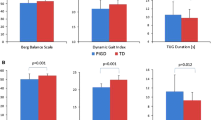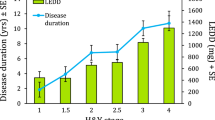Summary
Stride parameters were established in 17 patients with idiopathic Parkinson's disease (PD; mean age 68.8 yrs.; Hoehn-Yahr stages 2 and 3) and in 33 healthy age-matched controls. Free-walking speed was lower in PD as were stride length and cadence. Impaired locomotor synergies in PD were reflected by a higher coefficient of variation of stride length; step width and its coefficient of variation (the latter related to postural imbalance in locomotion) were not changed. No stride parameter correlated with any total score of either the Hoehn-Yahr Scale, the Unified Parkinson's Disease Rating Scale Motor Examination (“UPDRS-III”), the Columbia Rating Scale (CURS) or the Webster Rating Scale. Stride length correlated with a CURS-Bradykinesia-Score, whereas gait velocity correlated with UPDRS-III-Axial-Motor-Score and with the CURS-Bradykinesia-Score. Hypokinesia of gait in moderately disabled PD patients is best assessed by combined analysis of stride parameters and locomotion-related subscores from conventional rating scales.
Similar content being viewed by others
References
Baas H, Stecker K, Fischer PA (1983) Value and appropriate use of rating scales and apparative measurements in quantification of disability in Parkinson's disease. J Neural Transm [PD Sect] 5: 45–61
Blin O, Ferrandez AM, Pailhous J, Serratrice G (1990a) Une nouvelle methode d'analyse quantitative de la marche du Parkinsonien: Illustration sur 6 patients. Rev Neurol 146: 48–50
Blin O, Ferrandez AM, Serratrice G (1990b) Quantitative analysis of gait in Parkinson patients: increased variability in stride length. J Neurol Sci 98: 91–97
Blin O, Ferrandez AM, Pailhous J, Serratrice G (1991) Dopa-sensitive and Dopa-resistant gait parameters in Parkinson's disease. J Neurol Sci 103: 51–54
Bowes SG, Clark PK, Leeman AL, O'Neill CJA, Weller C, Nicholson PW, Deshmukh AA, Dobbs SM, Dobbs RJ (1990) Determinants of gait in the elderly Parkinsonian on maintenance levodopa/carbidopa therapy. Br J Clin Pharmacol 30: 13–24
Brinckmann P (1981) Die Richtung der Fu\längsachse beim Gehen. Z Orthop 119: 445–448
Delwaide PJ, Delmotte P (1989) Comparison of normal senile gait with parkinsonian gait. In: Calne DB, Crippa D, Comi G, Horowski R, Trabucchi M (eds) Parkinsonism and aging. Raven, New York, pp 229–237
Duvoisin RC (1971) The evaluation of extrapyramidal disease. In: De Ajuriaguerra J, Gauthier G (eds) Monoamines, noyaux gris centraux et de syndrome de Parkinson. Masson, Paris, pp 313–325
Fahn S, Elton RS, members of the UPDRS Development Committee (1987) Unified Parkinson's Disease Rating Scale. In: Fahn S, Marsden CD, Calne DB, Goldstein M (eds) Recent developments in Parkinson's disease, vol IL Macmillan, Florham Park, NJ, pp 153–163
Ferrandez AM, Pailhous J, Serratrice G (1988) Locomotion in the elderly. In: Amblard B, Berthoz A, Clarac F (eds) Posture and gait: development, adaption and modulation. Elsevier, Amsterdam, pp 115–124
Folstein MF, Folstein SE, McHugh PR (1975) “Mini-mental state”. A practical method for grading the cognitive state of patients for the clinician. J Psychiatry Res 2: 189–198
Forssberg H, Johnels B, Steg G (1986) Is Parkinsonian gait caused by a regression to an immature walking pattern? Adv Neurol 40: 375–379
Gabell A, Nayak USL (1984) The effect of age on variability in gait. J Gerontol 39: 662–666
Geminiani G, Cesena BM, Tamma F, Contri P, Pacchetti C, Carella F, Piolti R, Martignoni E, Giovannini P, Girotti F, Caraceni T (1991) Interobserver reliability between neurologists in training of Parkinson's disease rating scales. A multicenter study. Mov Disord 6: 330–335
Ginanneschi A, Degl'Innocenti F, Magnolfi S, Maurello MT, Catarzi P, Marini P, Amaducci P (1988) Evalution of Parkinson's disease: reliability of three rating scales. Neuroepidemiology 7: 38–41
Gibb WGP, Lees AJ (1988) The relevance of the Lewy body to the pathogenesis of idiopathic Parkinson's disease. J Neurol Neurosurg Psychiatry 51: 745–752
Hely MA, Chey T, Wilson A, Williamson PM, O'Sullivan DJ, Rail D, Morris JGL (1993) Reliability of the Columbia scale for assessing signs of Parkinson's disease. Mov Disord 8: 466–472
Henderson L, Kennard C, Crawford TJ, Day S, Everitt BS, Goodrich S, Jones F, Park DM (1991) Scales for rating motor impairment in Parkinson's disease: studies of reliability and convergent validity. J Neurol Neurosurg Psychiatry 54: 18–24
Hoehn MM, Yahr MD (1967) Parkinsonism: onset, progression and mortality. Neurology 17: 427–442
Johnels B, Ingvarsson PE, Thorselius M, Valls M, Steg G (1989) Disability profiles and objective quantitative assessment in Parkinson's disease. Acta Neurol Scand 79: 227–238
Klein C, Stolze H, Vieregge P (1996) Gait evaluation in neurology: reliability of stride parameters. Mov Disord 11 [Suppl 1]: 92
Knutsson E (1972) An analysis of parkinsonian gait. Brain 95: 475–486
Kunesch E, Schnitzler A, Tyercha C, Knecht S, Stelmach G (1995) Altered force release control in Parkinson's disease. Behav Brain Res 67: 43–49
Langston JW, Widner H, Goetz CG, Brooks D, Fahn S, Freeman T, Watts R (1992) Core assessment program for intracerebral transplantations (CAPIT). Mov Disord 7: 2–13
Marini C, Ferretti C, Di Gianfilippo G, Totaro R, D'Andrea F, Prencipe M (1992) Dynamic evaluation of gait in Parkinson's disease. In: Woollacott M, Horak F (eds) Posture and gait: control mechanisms, 1992. Xlth International symposium of the society for postural and gait research, Portland, May 24–27, 1992. University of Oregon Books
Martinez-Martin P, Gil-Nagel A, Gracia LM, Gomez JB, Martinez-Sarries J, Bermejo F, and the Cooperative Multicentric Group (1994) Unified Parkinson's Disease Rating Scale characteristics and structure. Mov Disord 9: 76–83
Morris ME, Iansek R, Matyas TA, Summers JJ (1994a) The pathogenesis of gait hypokinesia in Parkinson's disease. Brain 117: 1169–1181
Morris ME, Iansek R, Matyas TA, Summers JJ (1994b) Ability to modulate walking cadence remains intact in Parkinson's disease. J Neurol Neurosurg Psychiatry 57: 1532–1534
Miller RA, Thaut MH, McIntosh GC, Rice RR (1996) Components of EMG symmetry and variability in parkinsonian and healthy elderly gait. Electroencephalogr Clin Neurophysiol 101: 1–7
Murray MP, Sepic BS, Gardner GM, Downs WJ (1978) Walking patterns of men with Parkinsonism. Am J Phys Med 57: 278–294
Pedersen SW, Eriksson T, Öberg B (1991) Effects of withdrawal of antiparkinson medication on gait and clinical score in the Parkinson patient. Acta Neurol Scand 84: 7–13
Richards M, Marder K, Cote L, Mayeux R (1994) Interrater reliability of the Unified Parkinson's Disease Rating Scale motor examination. Mov Disord 9: 89–91
Stern GM, Franklyn SE, Imms FJ, Prestidge SP (1983) Quantitative assessment of gait and mobility in Parkinson's disease. J Neural Transm 19: 201–214
Stolze H, Vieregge P, Kömpf D (1994) Quantitative gait analysis and motor dysfunction in Parkinson's disease. Mov Disord 9 [Suppl 1]: 70
Taylor AE, Saint-Cyr JA, Lang AE (1986) Frontal lobe dysfunction in Parkinson's disease: the cortical focus of neostriatal outflow. Brain 109: 845–863
Thaut MH, McIntosh GC, Rice RR, Miller RA, Rathbun J, Brault JM (1996) Rhythmic auditory stimulation in gait training for Parkinson's disease patients. Mov Disord 11: 193–200
Ueno E, Yanagisawa N, Takami M (1993) Gait disorders in parkinsonism. A study with floor reaction forces and EMG. Adv Neurol 60: 414–418
Vieregge P, Kaufmann U, Schäfer C, Steinauer K, Fey A, Klein C, Heberlein I, Zurloh A (1996a) Gangstörung als reduzierte sozial-praktische Kompetenz im Alter-Quantitative und Videofilm-gestützte Erfassung als Grundlage geriatrischer Rehabilitation. Geriat Forsch 6: 123–140
Vieregge P (1996b) Idiopathische Gangstörung im Alter-Klinische Phänomenologie und quantitative Erfassung. Huber, Bern Göttingen Toronto
Webster DD (1968) Critical analysis of the disability in Parkinson's disease. Mod Treatm 5: 257–282
Weller C, Humphrey SJE, Kirollos C, Bowes SG, Charlett A, Dobbs SM, Dobbs RJ (1992) Gait on a shoestring: falls and foot separation in Parkinsonism. Age Aging 21: 242–244
Weller C, O'Neill CJA, Charlett A, Bowes SG, Purkiss A, Nicholson PW, Dobbs RJ, Dobbs SM (1993) Defining small differences in efficacy between anti-Parkinsonian agents using gait analysis: a comparison of two controlled release formulations of levodopa/decarboxylase inhibitor. Br J Clin Pharmacol 35: 379–385
Zetusky WJ, Jankovic J, Pirozzolo FJ (1985) The heterogeneity of Parkinson's disease: clinical and prognostic implications. Neurology 35: 522–526
Author information
Authors and Affiliations
Rights and permissions
About this article
Cite this article
Vieregge, P., Stolze, H., Klein, C. et al. Gait quantitation in Parkinson's disease — locomotor disability and correlation to clinical rating scales. J. Neural Transmission 104, 237–248 (1997). https://doi.org/10.1007/BF01273184
Received:
Accepted:
Issue Date:
DOI: https://doi.org/10.1007/BF01273184




